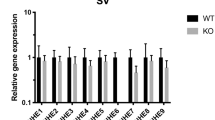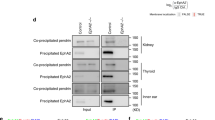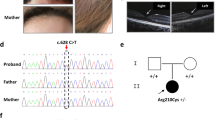Abstract
H + -ATPases are ubiquitous in nature; V-ATPases pump protons against an electrochemical gradient, whereas F-ATPases reverse the process, synthesizing ATP. We demonstrate here that mutations in ATP6B1 , encoding the B-subunit of the apical proton pump mediating distal nephron acid secretion, cause distal renal tubular acidosis, a condition characterized by impaired renal acid secretion resulting in metabolic acidosis. Patients with ATP6B1 mutations also have sensorineural hearing loss; consistent with this finding, we demonstrate expression of ATP6B1 in cochlea and endolymphatic sac. Our data, together with the known requirement for active proton secretion to maintain proper endolymph pH, implicate ATP6B1 in endolymph pH homeostasis and in normal auditory function. ATP6B1 is the first member of the H + -ATPase gene family in which mutations are shown to cause human disease.
This is a preview of subscription content, access via your institution
Access options
Subscribe to this journal
Receive 12 print issues and online access
$209.00 per year
only $17.42 per issue
Buy this article
- Purchase on Springer Link
- Instant access to full article PDF
Prices may be subject to local taxes which are calculated during checkout





Similar content being viewed by others
References
Bastani, B. & Gluck, S.L. New insights into the pathogenesis of distal renal tubular acidosis. Miner. Electrolyte Metab. 22, 396–409 (1996).
Batlle, D.C., Sehy, J.T., Roseman, M.K., Arruda, J.A. & Kurtzman, N.A. Clinical and pathophysiologic spectrum of acquired distal renal tubular acidosis. Kidney Int. 20, 389–396 ( 1981).
Lightwood, R. Communication no. 1. Arch. Dis. Child. 10, 205 (1935).
Butler, A.M., Wilson, J.L. & Farber, S. Dehydration and acidosis with calcification at renal tubules. J. Pediatr. 8, 489 ( 1936).
Royer, P. & Broyer, M. L'acidose renale au cours des tubulopathies congenitales. in Proceedings of Actualites Nephrologiques de l'Hopital Necker (Flammarion, Paris, 1967).
Nance, W.E. & Sweeney, A. Evidence for autosomal recessive inheritance of the syndrome of renal tubular acidosis with deafness. Birth Defects Orig. Artic Ser. 7, 70– 72 (1971).
Walker, W.G. Renal tubular acidosis and deafness. Birth Defects Orig. Artic Ser. 7, 126 (1971).
Donckerwolcke, R.A., van Biervliet, J.P., Koorevaar, G., Kuijten, R.H. & van Stekelenburg, G.J. The syndrome of renal tubular acidosis with nerve deafness. Acta Paediatr. Scand. 65, 100–104 (1976).
Brown, M.T., Cunningham, M.J., Ingelfinger, J.R. & Becker, A.N. Progressive sensorineural hearing loss in association with distal renal tubular acidosis. Arch. Otolaryngol. Head Neck Surg. 119, 458–460 (1993).
Zakzouk, S.M., Sobki, S.H., Mansour, F. & Al Anazy, F.H. Hearing impairment in association with distal renal tubular acidosis among Saudi children. J. Laryngol. Otol. 109, 930–934 (1995).
Misrahy, G.A., Hildreth, K.M., Clark, L.C. & Shinabarger, E.W. Measurement of the pH of endolymph in the cochlea of guinea pigs. Am. J. Physiol. 194, 393–395 (1958).
Tasaki, I. & Spyropoulos, C.S. Stria vascularis as source of endocochlear potential. J. Neurophysiol. 22, 149–155 (1959).
Sellick, P.M. & Johnstone, B.M. Production and role of inner ear fluid. Prog. Neurobiol. 5, 337– 362 (1975).
Sterkers, O., Saumon, G., Huy, P.T.B., Ferrary, E. & Amiel, C. Electrochemical heterogeneity of the cochlear endolymph: effect of acetazolamide. Am. J. Physiol. 246, F47–F53 (1984).
Györy, A.K. & Edwards, K.D.G. Renal tubular acidosis. A family with an autosomal dominant genetic defect in renal hydrogen ion transport, with proximal tubular and collecting duct dysfunction and increased metabolism of citrate and ammonia. Am. J. Med. 45, 43–62 (1968).
Bruce, L.J. et al. Familial distal renal tubular acidosis is associated with mutations in the red cell anion exchanger (band 3, AE1) gene. J. Clin. Invest. 100, 1693–1707 (1997).
Jarolim, P. et al. Autosomal dominant distal renal tubular acidosis is associated in three families with heterozygosity for the R589H mutation in the AE1 (band 3) Cl-/HCO3- exchanger. J. Biol. Chem. 273, 6380–6388 (1998).
Karet, F.E. et al. Mutations in the chloride-bicarbonate exchanger gene AE1 cause autosomal dominant but not autosomal recessive distal renal tubular acidosis. Proc. Natl Acad. Sci. USA 95, 6337– 6342 (1998).
Lander, E.S. & Botstein, D. Homozygosity mapping—a way to map human recessive traits with the DNA of inbred children. Science 236, 1567–1570 ( 1987).
Kruglyak, L., Daly, M.J., Reeve-Daly, M.P. & Lander, E.S. Parametric and nonparametric linkage analysis: a unified multipoint approach. Am. J. Hum. Genet. 58, 1347– 1363 (1996).
Nelson, R.D. et al. Selectively amplified expression of an isoform of the vacuolar H+-ATPase 56-kilodalton subunit in renal intercalated cells. Proc. Natl Acad. Sci. USA 89, 3541– 3545 (1992).
Stevens, T.H. & Forgac, M. Structure, function and regulation of the vacuolar (H+)-ATPase. Annu. Rev. Cell Dev. Biol. 13, 779–808 (1997).
Boyer, P.D. The ATP synthase—a splendid molecular machine. Annu. Rev. Biochem. 66, 717–749 ( 1997).
Südhof, T.C., Fried, V.A., Stone, D.K., Johnston, P.A. & Xie, X.S. Human endomembrane H+ pump strongly resembles the ATP-synthetase of Archaebacteria. Proc. Natl Acad. Sci. USA 86, 6067–6071 ( 1989).
Mitchell, P. Coupling of phosphorylation to electron and hydrogen transfer by a chemi-osmotic type of mechanism. Nature 191, 144– 148 (1961).
Bernasconi, P., Rausch, T., Struve, I., Morgan, L. & Taiz, L. An mRNA from human brain encodes an isoform of the B subunit of the vacuolar H+-ATPase. J. Biol. Chem. 265, 17428–17431 (1990).
Puopolo, K., Kumamoto, C., Adachi, I., Magner, R. & Forgac, M. Differential expression of the "B" subunit of the vacuolar H+-ATPase in bovine tissues. J. Biol. Chem. 267, 3696–3706 (1992).
van Hille, B. et al. Heterogeneity of vacuolar ATPase: differential expression of two human subunit B isoforms. Biochem J. 303, 191–198 (1994).
Abrahams, J.P., Leslie, A.G.W., Lutter, R. & Walker, J.E. Structure at 2.8 angstrom resolution of F1-ATPase from bovine heart mitochondria. Nature 370, 621–628 (1994).
Batlle, D. & Flores, G. Underlying defects in distal renal tubular acidosis: new understandings. Am. J. Kidney Dis. 6, 896–915 (1996).
Stankovic, K.M., Brown, D., Alper, S.L. & Adams, J.C. Localization of pH regulating proteins H+ATPase and Cl–/HCO 3– exchanger in guinea pig inner ear. Hearing Res. 114, 21–34 (1997).
Canlon, B. & Brundin, L. Mechanically induced length changes of isolated outer hair cells are metabolically dependent. Hearing Res. 53, 7–16 ( 1991).
Cremers, C.W.R.J., Monnens, L.H. & Marres, E.H.M.A. Renal tubular acidosis and sensorineural deafness: an autosomal recessive syndrome. Arch. Otolaryngol. 106, 287–289 (1980).
Bell, G., Karam, J. & Rutter, W. Polymorphic DNA region adjacent to the 5'-end of the human insulin gene. Proc. Natl Acad. Sci. USA 78, 5759–5763 (1981).
Craig, H.D. et al. Multilocus linkage identifies two new loci for a Mendelian form of stroke, cerebral cavernous malformation, at 7p15-13 and 3q25.2-27. Hum. Mol. Genet. 7, 1851– 1858 (1998).
Liu, Y-G. & Whittier, R.F. Thermal asymmetric interlaced PCR—automatable amplification and sequencing of insert end fragments from P1 and YAC clones for chromosome walking. Genomics 25, 674–681 (1995).
Shimkets, R.A. et al. Liddle's syndrome: heritable human hypertension caused by mutations in the b-subunit of the epithelial sodium channel. Cell 79, 407–414 ( 1994).
Rost, B. & Sander, C. Prediction of protein secondary structure at better than 70% accuracy. J. Mol. Biol. 232, 584–599 (1993).
Robertson, N.G., Khetarpal, U., Gutierrez-Espeleta, G.A., Bieber, F.R. & Morton, C.C. Isolation of novel and known genes from a human fetal cochlear library using subtractive hybridization and differential screening. Genomics 23, 42– 50 (1994).
Chomczynski, P. & Sacchi, N. Single-step method of RNA isolation by guanidinium isothiocyanate phenol chloroform extraction. Anal. Biochem. 162, 156– 159 (1987).
Hasson, T. et al. Unconventional myosins in inner-ear sensory epithelia. J. Cell Biol. 137, 1287–1307 (1997).
Acknowledgements
We thank the families for their invaluable contribution to this study; W.G. Walker for provision of kindred RTA2; C. Nelson-Williams for management of the DNA database; T. Mansfield for development and implementation of the fluorescence-labelled genotyping panel; H. Rye for assistance with crystallographic interpretation; C. Hecht for provision of adult cochlear epithelium; T. Hasson for advice and provision of anti-myosin VI antibody; D. Biemesderfer for provision of mouse kidney sections; and H. Craig, D. Geller, A. Gharavi and M. Kashgarian for helpful discussions. C.C.M. and A.B.S. are supported in part by NIH grant DCO3402. F.E.K. is a Fellow of the Wellcome Trust. K.E.F. is an investigator of the Medical Scientist Training Program. R.P.L. is an investigator of the Howard Hughes Medical Institute.
Author information
Authors and Affiliations
Corresponding author
Rights and permissions
About this article
Cite this article
Karet, F., Finberg, K., Nelson, R. et al. Mutations in the gene encoding B1 subunit of H+-ATPase cause renal tubular acidosis with sensorineural deafness. Nat Genet 21, 84–90 (1999). https://doi.org/10.1038/5022
Received:
Accepted:
Issue Date:
DOI: https://doi.org/10.1038/5022



